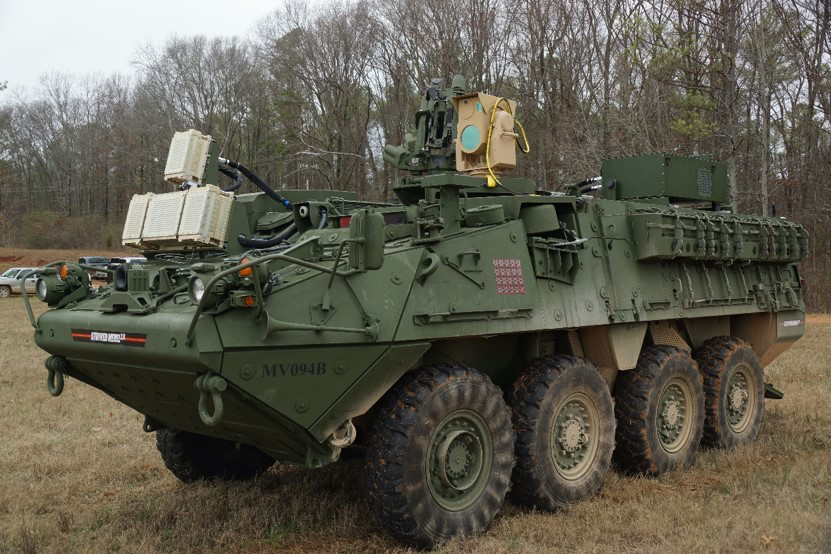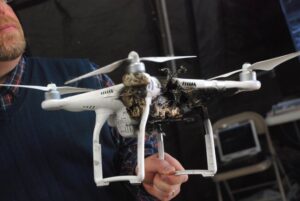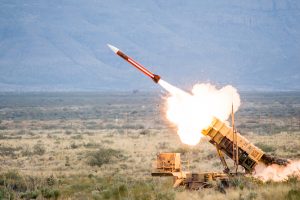AUSA: The Army is investing more and more money in lasers to defeat incoming rockets and enemy drones.
Across the Air & Missile Defense (AMD) portfolio, “we put over 50 percent of our S&T (Science and Technology) money going towards directed energy projects,” up from about a third previously, said the AMD modernization director, Brig. Gen. Randall McIntire.
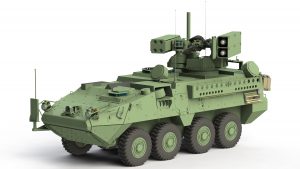
Anti-aircraft Stryker variant chosen by the US Army for its Interim Maneuver Short-Range Air Defense (IMSHORAD) program: 4 Stinger missiles on one side, two Hellfires on the other, with a 30 mm autocannon (and 12.7 mm machinegun) in between (Leonardo DRS)
To meet an urgent deadline for initial deployment in 2020, the Interim Maneuver Short-Range Air Defense (IMSHORAD) system now going on 8×8 Strykers had to use existing, off-the-shelf technologies. That means the first two battalions of air defense Strykers, to be fielded by 2022, will mount a combination of missile launchers and machineguns.
But the full-up MSHORAD will be “less about missile technology” and have “more of a directed-energy focus,’ McIntire told reporters at last week’s at the Association of the US Army conference. MSHORAD will also probably have electronic warfare systems to jam the transmissions directing enemy drones, although that’s not yet final. (I heard no discussion of another promising technology, microwaves to burn out electronics at a distance).
MSHORAD will be the next step from the Army’s ongoing Multi-Mission High-Energy Laser (MMHEL) experiments with Stryker-mounted lasers, which aim to field-test a 50kW weapon in 2021. (That would qualify the laser for Technology Readiness Level (TRL) 7). The Army aims to field the 50 kw weapon by 2023.
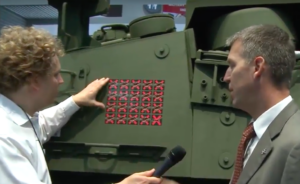
Kill count: A Boeing rep shows us how many drones the Stryker-mounted 2-kilowatt laser has shot down in testing.
Tests have shown 2kW and 5 kW weapons can burn out incoming drones, providing valuable lessons for future training and tactics. “One of the things we need to do is start to build a bench of directed energy experts,” McIntire said, before the Army is ready to field laser weapons.
But McIntire’s Cross Functional Team (CFT) sees 50kW as the crucial threshold to make a laser useful in actual combat. Why? Doubling a laser’s power level halves the time it takes to burn out a given target at a given range, and McIntire wants the system to kill low-end drones in “less than a second” so it can wipe out incoming swarms before they get through. Higher power can also give longer range or take on harder targets.
In parallel to the 50 kW Stryker laser, the Army is developing a 100 kW laser mounted on a larger but less mobile vehicle, the Oshkosh FMTV truck. (The latest model, the A2, just debuted at AUSA). This heavier weapon would follow behind the MSHORAD Strykers as part of the Army’s second line of defense, the Indirect Fire Protection Capability.
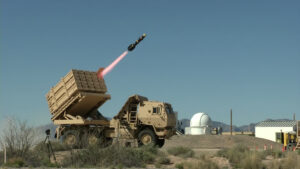
Army Indirect Fire Protection Capability (IPFC) Multi-Mission Launcher (MML) test-fires a Longbow Hellfire.
Truck-mounted IFPC lasers and missiles would protect command posts, helicopter rearming points, supply dumps, and other support sites against cruise missiles, air attack, and long-range rockets. MSHORAD accompanies frontline combat units to defend against shorter-range threats. A future “multi-mission air and missile defense” battalion would have elements of both, McIntire said. Ultimately, he said, the same unit might mix both offensive and defensive capabilities, able to both destroy enemy launchers before they fire and destroy any missiles that are launched.
McIntire & co. are also recommending some kind of air defense laser go on the future Next Generation Combat Vehicle. The first member of the NGCV family, an Optionally Manned Fighting vehicle to replace the M2 Bradley, is supposed to enter service in 2026, with completely robotic combat vehicles to follow.
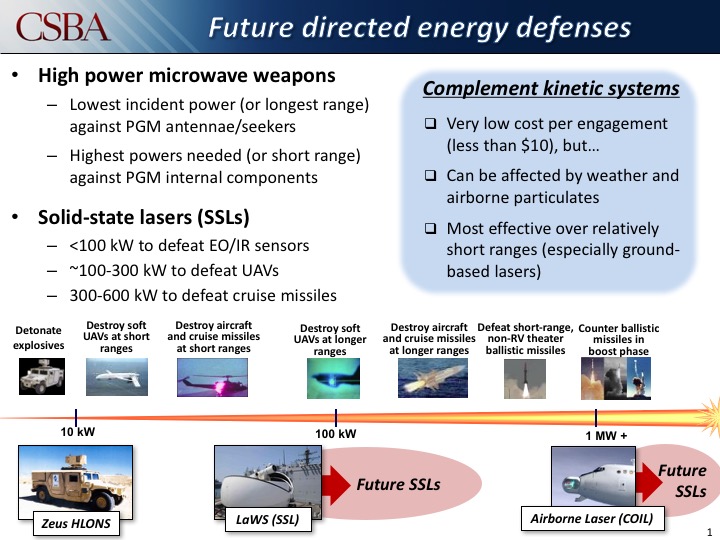
Estimated power ranges for lasers to shoot down different types of targets (Center for Strategic & Budgetary Assessments)
Lasers & Jammers: Potential & Limits
Why switch from missiles and bullets to photons and electrons? It’s about cost and ammunition capacity. Guns are relatively cheap, but they’re also fairly short-ranged, McIntire explained. Missiles have the range, but they’re “becoming extraordinarily expensive,” often costing more than the targets they shoot down. That means the Army can’t afford enough to counter the massed barrages favored by Russian and Chinese doctrine. Even if money were no object, there’s only so many missiles you can fit on a vehicle at once, and when you’ve shot them all, the rest of the incoming salvo has a free pass until you can resupply.
Lasers and jammers, by contrast, can keep zapping targets as long as they have electrical power. The marginal cost per shot is just the cost of diesel fuel to generate electricity, and the number of shots is limited only by the size of your gas tank or battery. They’re also less likely to do collateral damage, since laser beams are inherently highly accurate — they’re photons moving at the speed of light in a straight line — and jamming beams disrupt radio-frequency transmissions without causing physical damage at all.
But beams also have real limits
Electronic warfare can’t jam the enemy’s transmissions until your intelligence figures out what frequencies they’re on. Further, the more autonomous the drone, the longer it can function without communication with its human operator. A cheap quadcopter may crash as soon as you jam it, but a true Artificial Intelligence could conduct the entire mission on its own, jamming be damned.
Lasers will heat up and destroy whatever they focus on, given time — but bad weather, even rainfall, will weaken the beam. On a rainy day, laser defenses may be useless, inviting attack, just as the Nazis saved their final offensive in the Battle of the Bulge for a spell of bad weather that grounded US airpower.
The nature of the target also matters. While a laser-reflecting mirrored surface is difficult to keep up in combat conditions, heat–absorbing material is already common on ballistic missile warheads, which must survive the intense heat of reentering the atmosphere.
That’s why the Army continues to invest, albeit less urgently, in upgrading physical weapons. Upgrades to the Patriot system, including the new MSE missile, improved displays, and the ability to share target data with THAAD, reinforce the Army’s defense against ballistic missiles. On the tactical level, a new air-bursting round for the Army’s new 30mm cannon and a new proximity fuse for the venerable Stinger missile will help them take out lightweight targets, like drones, even if they don’t score a direct hit
Lasers are a big part of future air and missile defense, McIntire said, but alongside guns and missiles: “You’re always going to need this mixture.”
Air Force picks Anduril, General Atomics for next round of CCA work
The two vendors emerged successful from an original pool of five and are expected to carry their drone designs through a prototyping phase that will build and test aircraft.
















